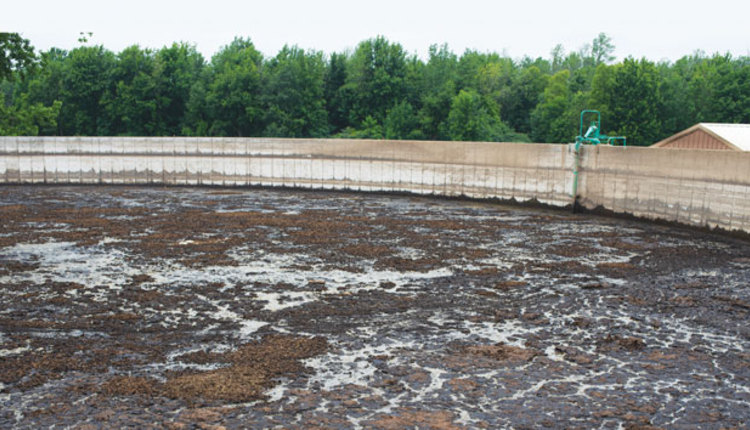
After a busy fall of harvest comes another manure application season. It is also the time of year when there is an uptick in accidents and deaths related to manure storage. From 1960 to 2016, there were over 150 deaths from manure storage gas exposure, with half of these accidents occurring on dairy farms. Unfortunately, one in five of these incidents involved the death of a second person who was trying to provide help.
Amy Schmidt, an associate professor of biological systems engineering and animal sciences at the University of Nebraska-Lincoln, outlined five tips for a safe and successful manure application process in a University of Nebraska Extension dairy webinar.
1. Fence in manure storage areas.
“I have been to a number of farms where the manure pit is very much exposed,” described Schmidt.
Exposed lagoons can make it easy for people to accidentally fall or drive into them. Fences and guardrails help to give a lay of the land, especially during dusk and dawn, when the sunlight makes it difficult to see. It also provides a physical barrier for distracted drivers. Always have a fence around your manure storage.
Numerous lagoons have liners, which make climbing out after falling in nearly impossible. By having a fence and posting visual warnings, these accidents can be prevented.
2. Recognize the risks of hydrogen sulfide.
The single biggest concern to manure application is deadly gases, and chief among them is hydrogen sulfide (H2S). “You really have no idea if the concentration of hydrogen sulfide is deadly unless you are measuring it,” said Schmidt.
At its lowest concentration, H2S smells like rotten eggs. With a concentration of 5 parts per million (ppm), symptoms include nausea, tears, and headache. When you double that concentration, someone can experience fatigue, headache, irritability, and dizziness.
Once levels reach 50 to 60 ppm, coughing and eye and throat irritation become problematic. Over 100 ppm, a person will have eye and respiratory tract irritation including fluid in the lungs. When levels reach 300 to 500 ppm, victims will stagger, collapse, and can die within 30 minutes. Once over this threshold, death can occur even more quickly.
“We tend to think that gases are only an issue in confined spaces with limited ventilation,” explained Schmidt, but that is hardly the case. Weather can play a factor as well, and she shared one example of this. “There was fog near the ground and the gas was released while the pit was agitating. Since hydrogen sulfide is heavier than air, the gas concentrated around the area, killing the farmer and 16 animals.”
Schmidt encouraged farmers to invest in personal protection equipment, like a H2S monitor and a ventilator. She also advised, “At minimum, make sure you have someone else outside of the manure storage area who can pull you out if there is trouble. You want to have a harness or rope so they can get you out of the area quickly without them entering.”
3. Conduct proper training.
Training everyone on your farm to recognize the signs of gas exposure and how to get help can be lifesaving. Key signs for gas exposure include a sense of being hot and clammy, loss of motor skills, fast heartbeat, tightness in the chest, panting, nausea, vomiting, and anxiety.
“If you are feeling this way, you need to get out of the area as soon as possible and into the fresh air. Schmidt explained, “There might have already been damage, but if you get outside, someone is more likely to find you and get you help.”
But recognizing the symptoms is only half the equation. Employees also need to know how to get help. It is important that everyone knows the farm address to tell emergency responders and can accurately describe the location on the farm. Finally, it is important to stress that no one enter the manure storage to attempt a rescue; wait for help to arrive.
4. Recognize the potential for methane pockets.
In swine manure systems, there are usually slotted floors with manure storage underneath, leading to limited oxygen content. Anerobic microbes break down carbon in these pits and create methane foam. Methane is highly flammable and can asphyxiate someone at a concentration of 50% or above.
“It’s important to inspect storages for foam regularly; it can pop up overnight,” stated Schmidt. Agitation of the pit can help break down the foam, but it needs to be done with caution, and make sure the equipment does not create sparks.
5. Heed equipment warning signs.
We have all seen the warning stickers posted on tractors and equipment. While we may glance over them, they provide an important reminder. Tractor power takeoffs (PTOs), guard shields, and deadman switches are in place for our protection. In less populated areas, it may take longer for emergency personnel to arrive, and rescue services may not be as sophisticated.
It is equally important to make sure employees understand how to use equipment and are assured they will receive help if they ask for it. Often, employees are hesitant to ask for help out of fear of being fired or taking up even more time during an already busy day. But long hours and time crunches lead to accidents; an estimated 80% of these accidents are a result of carelessness. “It is important to stop and think,” Schmidt emphasized.
These five tips can be lifesaving on the farm during the fall and spring manure application seasons, and every life counts. “If sharing these tips can prevent injuries or deaths, then I am hopeful that message is received,” said Schmidt.
This article appeared in the February 2021 issue of Management on page 4.
Not a subscriber? Click to get the print magazine.






